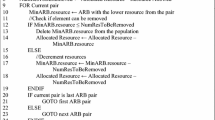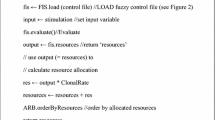Abstract
The use of expert systems and artificial intelligence techniques in disease diagnosis has been increasing gradually. Artificial Immune Recognition System (AIRS) is one of the methods used in medical classification problems. AIRS2 is a more efficient version of the AIRS algorithm. In this paper, we used a modified AIRS2 called MAIRS2 where we replace the K- nearest neighbors algorithm with the fuzzy K-nearest neighbors to improve the diagnostic accuracy of diabetes diseases. The diabetes disease dataset used in our work is retrieved from UCI machine learning repository. The performances of the AIRS2 and MAIRS2 are evaluated regarding classification accuracy, sensitivity and specificity values. The highest classification accuracy obtained when applying the AIRS2 and MAIRS2 using 10-fold cross-validation was, respectively 82.69% and 89.10%.

Similar content being viewed by others
References
National Diabetes Information Clearinghouse (NDIC). http://diabetes.niddk.nih.gov/dm/pubs/diagnosis/
K. Polat, S. Günes. An expert system approach based on principal component analysis and adaptive neuro-fuzzy inference system to diagnosis of diabetes disease. Digital Signal Processing, pp. 702–710, 2007.
S. W. Purnami, A. Embong, J. M. Zain, S. P. Rahayu, A New Smooth Support Vector Machine and Its Applications in Diabetes Disease Diagnosis, Journal of Computer Science, pp. 1003–1008, 2009.
S. Şahan, K. Polat, H. Kodaz, and S. Güneş. The Medical Applications of Attribute Weighted Artificial Immune System (AWAIS): Diagnosis of Heart and Diabetes Diseases. ICARIS 2005, LNCS 3627, pp. 456–468, 2005.
K. Polat and S. Gunes. An improved approach to medical data sets classification: artificial immune recognition system with fuzzy resource allocation mechanism. Expert Systems, pp. 252–270, 2007.
B. Ster and A. Dobnikar. Neural networks in medical diagnosis: comparison with other methods. International Conference on Engineering Applications of Neural Networks, pp. 427–430, 1996.
L. Nunes de Castro, F. J. Von Zuben. Artificial immune systems: part I—basic theory and applications. Technical Report. TR – DCA 01/99, 1999.
L. Nunes de Castro, F. J. Von Zuben.. Artificial immune systems: part II—a survey of applications. Technical Report. TR – DCA 01/99, 1999.
J. Timmis, T. Knight, L.N. de Castro and E. Hart. An Overview of Artificial Immune Systems. In Paton R, Bolouri H, Holcombe M, Parish J H, and Tateson R (Eds.) “Computation in Cells and Tissues: Perspectives and Tools for Thought”, Natural Computation Series, pp. 51–86, 2004.
U. Aickelin and D. Dasgupta. ARTIFICIAL IMMUNE SYSTEMS. In: Burke E. K.; Kendall G. (Eds.) Search Methodologies: Introductory Tutorials in Optimization and Decision Support Techniques, pp. 375–399, 2005.
Nunes de Castro, L., and Von Zuben, F. J., Learning and Optimization Using the Clonal Selection Principle. IEEE Transactions on Evolutionary Computation - TEC 6(3):239–251, 2002.
J. Greensmith, A. Whitbrook, U. Aickelin. Artificial Immune Systems. In Gendreau M, Potvin J.Y. (Eds.) Handbook of Metaheuristics, 2nd edition, pp. 421–448, 2010.
A. Watkins, J. Timmis. Artificial Immune Recognition System (AIRS): An Immune-Inspired Supervised Learning Algorithm. Genetic Programming and Evolvable Machines, pp. 291–317, 2004.
A. Watkins, J. Timmis. Artificial Immune Recognition System (AIRS): Revisions and Refinements. In J. Timmis and P.J. Bentley, editors, 1st International Conference on Artificial Immune Systems (ICARIS2002), pp. 173–181, 2002.
A. Watkins and L. Boggess. “A New Classifier Based on Resource Limited Artificial Immune Systems”. In Proceedings of Congress on Evolutionary Computation, Part of the 2002 IEEE World Congress on Computational Intelligence held in Honolulu, HI, USA, pp. 1546–1551, 2002.
K. Polat, S. Gunes. Automated identification of diseases related to lymph system from lymphography data using artificial immune recognition system with fuzzy resource allocation mechanism (fuzzy-AIRS). Biomedical Signal Processing and Control, pp. 253–260, 2006.
K. Polat, S. Güneş. A new method to forecast of Escherichia coli promoter gene sequences: Integrating feature selection and Fuzzy-AIRS classifier system. Expert Systems with Applications, pp. 57–64, 2009.
K. Polat, S. Sahan, H. Kodaz, and S. Günes. Breast cancer and liver disorders classification using artificial immune recognition system (AIRS) with performance evaluation by fuzzy resource allocation mechanism. Expert Systems with Application, pp. 172–183, 2007.
J.M. Keller, M.R. Gray, J.A. Givens Jr., A fuzzy k-nearest neighbor algorithm, IEEE Trans. Syst. Man Cybern, pp. 580–585, 1985.
A. Sengur. An expert system based on principal component analysis, artificial immune system and fuzzy k-NN for diagnosis of valvular heart diseases. Computers in Biology and Medicine, pp. 329–338, 2008.
Author information
Authors and Affiliations
Corresponding author
Rights and permissions
About this article
Cite this article
Chikh, M.A., Saidi, M. & Settouti, N. Diagnosis of Diabetes Diseases Using an Artificial Immune Recognition System2 (AIRS2) with Fuzzy K-nearest Neighbor. J Med Syst 36, 2721–2729 (2012). https://doi.org/10.1007/s10916-011-9748-4
Received:
Accepted:
Published:
Issue Date:
DOI: https://doi.org/10.1007/s10916-011-9748-4




